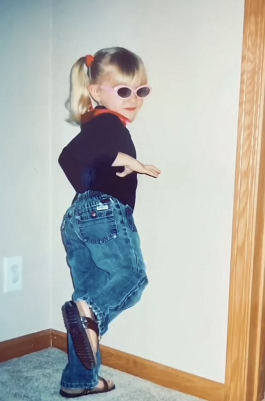Part 1
Bill Cunningham once said, “Fashion is the armor to survive everyday life.” I have always strived to dress differently from my peers. If I wasn't the kid with the best grades, or the one that could run the fastest, at least I would be the one to wear the coolest clothes. I wanted to wear the newest trends, long before others even knew about them. Young Kendall was trying to be a trendsetter, although looking back, some of those trends were very questionable.
Saturday mornings were spent going to thrift stores with my family to buy clothing with patterns or cool designs I liked. I was always afraid kids would make fun of me if they knew all my clothes were hand-me-downs or bought at the thrift store, so I would do everything in my power to make them look as new as possible. In fact, when I was 10 years old, I stole my mom’s pair of fabric scissors and I learned how to hand stitch from a YouTube video.The first thing I created was a pair of jeans that I embroidered little daisies onto the back pockets. When I wore them on the first day of 6th grade, I had so many people come up to me asking where I had bought them. They had no idea they were actually a pair of jeans I had found in the men's section at Goodwill.
make fun of me if they knew all my clothes were hand-me-downs or bought at the thrift store, so I would do everything in my power to make them look as new as possible. In fact, when I was 10 years old, I stole my mom’s pair of fabric scissors and I learned how to hand stitch from a YouTube video.The first thing I created was a pair of jeans that I embroidered little daisies onto the back pockets. When I wore them on the first day of 6th grade, I had so many people come up to me asking where I had bought them. They had no idea they were actually a pair of jeans I had found in the men's section at Goodwill.
Making slight adjustments to my clothes became a hobby of mine. One day I realized that half of the clothes I made, I wouldn’t even wear, they just sat in my closet waiting to be worn for the first time. The clothes piled up very fast. To make room for the newest items, my yearly closet clean out resulted in bags and bags of clothes that were all homemade. The clean out was a week long process of debating whether I should part ways with the piece I had made but never worn.
Over time, I had less and less time for my little hobby; but I still wanted to look trendy and cute. I also had to figure out how to do it on a budget. My solution was to shop at places like Shein or Romwe. These sites sold clothing at a low price but was low quality. That didn’t matter to me as long as I was ahead of the trend and wearing clothes that distinguished me. Little did I know, I was having a major impact on the environment.
I began taking notice when the low quality clothing I was wearing started staining my skin. By the end of the day I would have green and blue streaks dyed onto my skin from the trendy shirt that had taken someone two minutes to make. Like any concerned teenager, I googled what these dye marks would do to my body. After going down a rabbit hole of endless reviews, I learned that many people were experiencing the same skin discoloration when wearing clothes from Shein. A deep dive into the company revealed that Shein, along with similar companies, not only produce low quality items, but leave huge carbon footprints, along with very unfair labor practices.
A simple Google search beforehand could have saved me from buying from this kind of company.
Did you know that the fashion industry is responsible for 4-10% of all greenhouse gas emissions, is the third leading polluter on the planet and makes over 100 billion pieces of clothing a year. I didn’t! What is even more astonishing is that of those 100 billion pieces of clothing, only 1% is recycled while 87% makes its way into landfills or burned (Ruiz)!
To combat this problem, clothing companies have started giving incentives for their used clothing. For example, H&M gives discounts up to 20% if customers bring back their used H&M clothing. Nike accepts previously owned shoes and sells shoes that are made from recycled shoes. Other companies implementing a clothing recycling, reduce, or reuse program include:
- Madewell
- GAP
- Universal Standard
- UNIQLO
- The North Face
- Hanky Panky
- Parade
- American Eagle
- Carter’s
- Soma
- Nordstrom
- DSW Shoes
- Patagonia
- Eileen Fisher
Large companies like Nike and H&M have also started to educate their customers on the harm unused clothing can have on the environment and on the people making the clothing. Hopefully they will lead the way for other companies to do the same.
This problem got me thinking, what part can I play to bring awareness to this issue?
In January of 2023, I started my internship at the Iowa Waste Reduction Center. I came in with hopes of learning more about what I could do for a future profession in the environmental field. This was a great opportunity to put my biology and business experience to good use. The IWRC has given me endless opportunities to research topics I feel very passionate about, one being fashion.
After being exposed to several waste reduction efforts addressing many environmental issues (e.g., air pollution, energy, food waste, and recycling). I have been on a mission to find a solution to the problem of fast fashion in my community. There were so many ways I could take this idea, so I decided to start solely on my research. Since August, I have looked into what other universities have been doing for this issue, how large businesses have been fighting it, and how these businesses and non-profits have been educating and advertising about the harms of the fashion industry. For example, Iowa State University has been running pop up tents, selling previously owned clothing. I have also found that one thing universities have been doing is a mini thrift store.This got me thinking…the University of Northern Iowa already has a food pantry, why not have a clothes closet or mini thrift store too? I met with my boss and mentor Molly Wells, IWRC Communications and Public Relations Manager, to collaborate on ideas and develop a plan to dive into the possibilities of this happening on my campus.
Follow my journey in the IWRC newsletter, on the IWRC website, or on Facebook, Instagram and LinkedIn. There is a lot more to come so stay tuned!
Author

Kendall Lienemann
Environmental Intern

